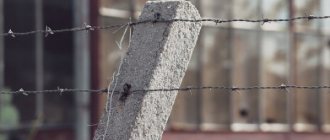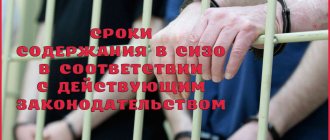A day in a pre-trial detention center and a colony settlement: how to count?
The scheme for counting time spent in a pre-trial detention center depends only on what type of correctional institution the court assigns when imposing a sentence of imprisonment.
The most “preferential conditions” by law are provided to those convicts who are sent from the walls of the isolation ward to serve their sentences in a penal colony . In accordance with Part 3.1 of Article 72 of the Criminal Code of the Russian Federation, one day in a pre-trial detention center will be counted as two days of imprisonment .
The logic of the “preferential” credit for time spent in a pre-trial detention center is that in a detention center, which is essentially a closed prison, a person is in harsher and more cramped conditions than in a colony-settlement.
In practice, there were cases when citizens whose investigation and trial lasted for many months and even years, thanks to this law, were released without having time to get to the colony.
Followers of Escobar
In the early 2010s, the developer Stroy-Invest planned to cut a plot of 20 hectares into 140 plots of 10 to 14 acres. It was planned to install electricity, sewerage and central heating. Water from wells. Let us remind you that the plots cost from 1.5 to 2.2 million rubles. For finished houses with an area of 155 to 230 square meters, the developer asked from 5.8 to 8 million rubles.
Life in “New Petersburg,” according to specialized portals about suburban real estate, stopped in 2012. The same house was also included in the photo in the advertisements, with a complete fence and gate. Announcement date: January 1, 2011.
The facility was declassified to the public after a call from an unknown migrant. It seems that he himself was taking away the remaining goods and could not contain what he saw.
The steep descent ends at a massive iron gate with one swinging leaf weighing half a ton. It has a meter by meter square window and a latch. There are drawings on the gate, more on them later. The entrance is crowned with the inscription Copenhagen. Two iron ramps for the exit, ankle-deep cold water under your feet.
If this is a prison, then the doghouse outside could also be part of the surroundings. Let's say they bring a person in a closed car, and he hears barking.
The photographs also show what the house looked like before its decline.
The fence is still in place. Three and a half meters high and made in such a way that the territory of the site is completely hidden. Note that the metal fence sheets on top are installed at an inward angle. It's harder to get out of it that way. Large gate, gate and closed peephole. The territory is well-groomed, the area is concreted, most likely this is the ceiling of the bunker, but beyond that there is a lawn. There are bars on the windows. The entrance to the underground prison is closed by a white typical garage door. Solar panels are installed on the roof.
There was a bathhouse behind the house. Everything here is as it should be - a steam room, a dressing room. It has some kind of fireplace. Large bags of coal then attracted attention. One is still there. But, as you know, the bathhouse is not heated with coal. A camouflaged hatch measuring about one meter by one meter was found. We know that when the Investigative Committee employees opened it, they discovered a wide well made of several concrete rings, three to four meters deep. There was also a hand winch, and there was water below. When they pumped it out and went down, they found a furnace that was the size of a human body. The pipe from it went through the same “fireplace”. Our interlocutors in the authorities did not confirm this for sure, but they say that they have the results of an examination about certain biological remains found in the oven. Although, “biology” can remain from anything, even from rodents.
Today there is a three-meter hole in this place; when examining the scene of the incident, they were obviously digging with an excavator, and the bathhouse was clearly moved a couple of meters by cable.
There is devastation all around now, everything is dug up and there are weeds. The house was three-room with a large attic. The nearest house is about two hundred meters away, the owner sometimes comes there. Three more a little further away. Here, in fact, are all the neighbors.
It was as if the building had been skinned from the inside. From the outside, one and a half meters of the bunker's walls are exposed. Nearby there is either a well with water, or a flooded communication line with the prison. There's a pile of tires in the backyard.
The approximate dimensions of the bunker are 15 by 15 meters, that is, more than 200 square meters. The concrete box was also dug up, its corners and perimeter are visible. The height inside the prison, let us remind you, is just over 2 meters. The thickness of the walls is approximately one meter. Water, electricity, sewerage are provided. We asked professional builders to estimate how much it would cost to build such a structure.
There was a bathhouse behind the house. Everything here is as it should be - a steam room, a dressing room. It has some kind of fireplace. Large bags of coal then attracted attention. One is still there. But, as you know, the bathhouse is not heated with coal. A camouflaged hatch measuring about one meter by one meter was found. We know that when the Investigative Committee employees opened it, they discovered a wide well made of several concrete rings, three to four meters deep. There was also a hand winch, and there was water below. When they pumped it out and went down, they found a furnace that was the size of a human body. The pipe from it went through the same “fireplace”. Our interlocutors in the authorities did not confirm this for sure, but they say that they have the results of an examination about certain biological remains found in the oven. Although, “biology” can remain from anything, even from rodents.
Today there is a three-meter hole in this place; when examining the scene of the incident, they were obviously digging with an excavator, and the bathhouse was clearly moved a couple of meters by cable.
There is devastation all around now, everything is dug up and there are weeds. The house was three-room with a large attic. The nearest house is about two hundred meters away, the owner sometimes comes there. Three more a little further away. Here, in fact, are all the neighbors.
Enrollment of a pre-trial detention center during a sentence in a general regime penal colony
For those who go to serve a sentence in a general regime , the time spent in a pre-trial detention center is counted as a day and a half . The situation is similar with minors who will serve their sentences in educational colonies.
Example: a citizen is sentenced to 5 years of imprisonment in a general regime penal colony. At the time of his transfer to the colony, he spent 12 months in a pre-trial detention center. Thus, his actual time served is already 1 year 6 months
The decision to count the length of stay in a pre-trial detention center is made by the court when passing a sentence.
When is the new calculation not used?
Modern legislation states when “a day and a half” should not be taken into account. There are several situations when the standard, previously used 1:1 ratio is taken. This innovation is not used in the following situations:
- A person has been convicted by a court of a serious criminal act.
- The criminal is involved in a case that is directly or indirectly related to terrorism.
- The offender has committed crimes more than once, that is, from the point of view of the Criminal Code, he is a dangerous repeat offender.
- The offender received a sentence under Art. 228. Here we are talking about illegal drug trafficking.
- A violator of the law comes under investigation for extortion, theft of drugs or psychotropic substances.
- The man was charged with treason against the state.
- The offender was charged with espionage activities. The collection, storage and theft of information, as well as its subsequent transfer to employees of government agencies in other countries, are punishable.
Criminals who have been charged under articles of grave and especially grave violations of the law are not subject to the updated preferential amendments to Art. 72.
How does a pre-trial detention center count toward a maximum security sentence?
For those who hope for a preferential credit for time in a pre-trial detention center when sent to a strict or special regime penal colony, we do not have the most optimistic news.
In accordance with Part 3.1 of Article 72 of the Criminal Code of the Russian Federation, the period of stay in a pre-trial detention center is counted towards the term of serving a sentence under strict and special regime day-by-day basis .
Many lawyers consider this state of affairs not very fair, however, this is the current law.
If you have questions for a lawyer about a specific situation, contact the online consultant on our website. It's free. Questions are accepted at any time of the day, seven days a week
About the prison hierarchy
Prison society is deeply hierarchical. This imposes strict limits on the system of relationships between convicts. First of all, the “suit” of the prisoner matters:
The backbone of the prison community, a sort of local elite. The thieves enjoy the maximum number of privileges, but many restrictions are also imposed on them. “According to the rules,” they are prohibited from working, obeying the administration, or cleaning, and previously thieves in law were not even allowed to have a family. The thieves adhere to strict rules, and if you learn them, there should be no problems. These people are interested in maintaining order in the cell, and from among them are appointed guards and overseers, designed to prevent lawlessness. It is better to treat them with respect, but without servility.
The most numerous class, so to speak, is the people. The men work quietly, live according to general rules and expect to quickly return to freedom, to ordinary society. If a first mover manages to avoid mistakes at the start, as a rule, he becomes a man. This is the ideal position.
But these are precisely the people who made these same mistakes (with the exception of voluntary homosexuals or those imprisoned for rape). Usually these are incorrectly spoken words and certain actions (theft from one’s own, denunciation to the administration, communication with other people from this caste). Previously, the ritual of “lowering” involved committing a homosexual act with a potential victim; now this is rare and mainly occurs among minors. In women's prisons and colonies, homosexual relations are not taboo at all.
The administration's collaborators, doing its dirty work in the hope of leniency. Being part of this group is low, so rarely does anyone cooperate with the administration voluntarily.
The bottom line is to keep your eyes and ears open at all times.
Basic questions about the innovation
People who are somehow affected by such an amendment have certain questions. Here are a few of the most popular ones.
Does the innovation apply to those under house arrest?
A convicted person under such arrest has the right to a reduction in the period of imprisonment. The following calculation operations apply here:
- Two days of arrest within the walls of the house - 1 day of the usual presence of the criminal in custody.
- Two days at home under arrest is a day of complete deprivation of a person’s freedom of movement.
How long will the innovations be taken into account?
Legal amendments regarding detention in pre-trial detention centers must be implemented within a strictly established time frame:
- For 3 months from the date of signing the law, to those violators who are kept in a colony or in a settlement.
- Within six months from the date of official signing of the law, criminals who are in colonies with the strictest regime. The same rule applies to people who have been ordered by the court to undergo a sentence of corrective work hours.
- For 6 months - for those occupying military positions and those in a specialized disciplinary unit. This rule also applies to those who are simply limited in their previous military service.
For people who were previously in pre-trial detention centers at the time the law was adopted, recalculation will be carried out in court. The basis is a written statement of the convicted person.








